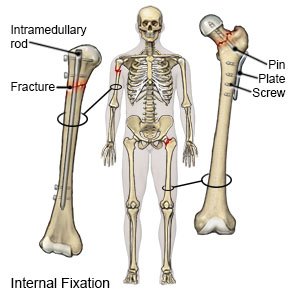ORIF of an Elbow Fracture in Children
Medically reviewed by Drugs.com. Last updated on Apr 6, 2025.
What do I need to know about open reduction and internal fixation (ORIF) of an elbow fracture?
ORIF of an elbow fracture is surgery to fix a broken elbow. Open reduction means the bone is moved back into the correct position. Internal fixation means hardware (such as rods or pins) is used to hold the broken bone together while it heals.
 |
How do I prepare my child for ORIF?
- Your child's surgeon will tell you how to prepare your child for surgery. He or she may tell you not to let your child eat or drink anything after midnight before surgery.
- Tell your child's surgeon about any medicines your child is taking. He or she will tell you if your child should stop any medicine for surgery, and when to stop. He or she will tell you which medicines your child should take or not take on the day of surgery.
- Your child may need to have blood and urine tests, and elbow x-rays.
What will happen during ORIF?
- Your child will be given general anesthesia to keep him or her asleep and free from pain during surgery. An incision will be made on or around your child's elbow fracture. Your child's surgeon will use plates, screws, pins, or wires to put the broken pieces back together. Damaged blood vessels and nerves will also be fixed.
- X-rays may be taken to see if the bones are in the correct position. The wound will be closed with stitches or medical tape and covered with bandages.
What will happen after ORIF?
Your child will be taken to a room to rest until he or she is fully awake. Healthcare providers will monitor him or her closely for any problems. Do not let your child get out of bed until his or her healthcare provider says it is okay. When healthcare providers see that your child is okay, he or she may be able to go home.
- A cast or splint may be placed to help prevent movement so the bones can heal.
- Medicines may be given to prevent or relieve pain or nausea.
What are the risks of ORIF for an elbow fracture?
Nerves, ligaments, and muscles may be damaged during surgery. Your child's arm, hand, or fingers may become stiff, numb, or weak. The broken elbow may not heal properly. Your child may not be able to move the elbow the way he or she did before the injury. He or she may have trouble going back to his or her usual activities.
Care Agreement
You have the right to help plan your child's care. Learn about your child's health condition and how it may be treated. Discuss treatment options with your child's healthcare providers to decide what care you want for your child. The above information is an educational aid only. It is not intended as medical advice for individual conditions or treatments. Talk to your doctor, nurse or pharmacist before following any medical regimen to see if it is safe and effective for you.© Copyright Merative 2025 Information is for End User's use only and may not be sold, redistributed or otherwise used for commercial purposes.
Further information
Always consult your healthcare provider to ensure the information displayed on this page applies to your personal circumstances.
